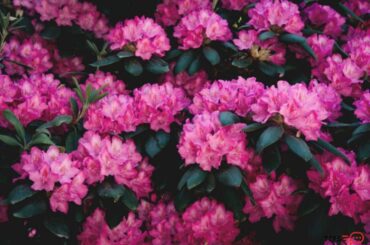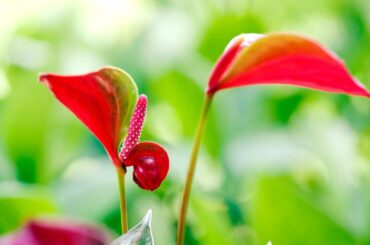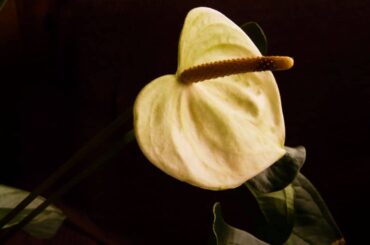Have you ever considered homemade fertilizer for Anthuriums? If not this article is for you. Well-nourished anthuriums grown under the right conditions bloom year-round. Anthuriums benefit from fertilizers and Like other plants, anthuriums require nutritious diets to perform well. Here, some elements in the diet have to be highlighted for some special purposes.
Fertilization of anthuriums should be done with a good understanding. This enables you to accomplish your intended goals with your lovely plants. So, how are you going to treat your anthuriums with a nutritious diet? Continue reading this article for more information.

What is the best homemade fertilizer for anthurium?
Anthuriums, also known as flamingo flowers, are fascinating beauties that anyone would love to have in their home. It is no wonder anthuriums have gained popularity worldwide with their vibrant, charming blooms and artistic foliage. Before addressing the above question, I would like to highlight some important points regarding homemade fertilizers for your lovely anthuriums.
Nutrients are continually accumulating in the soil in nature. So, plants that are rooted in the soil often gain nutrients substantially from the soil. But once the plants are potted, the nutrient elements in the soil are depleted with time. Therefore, it is crucial to replenish these nutrients regularly. To counteract this problem, the use of homemade fertilizers would be an effective start.
You can make fertilizers on your own with materials that are commonly available in your home. With homemade fertilizers, you can address the nutrient needs of your anthuriums in an eco-friendly way. Unlike synthetic fertilizers, homemade fertilizers prevent any chemical buildup in the plant soil. Commonly used homemade fertilizers for anthuriums include compost, banana peels, coffee grounds, and so on.
Compost
Compost is the most popular homemade fertilizer for any houseplant. Microbial decomposition of organic materials results in nutrient-rich loamy soil, which is ideal for anthuriums. You can apply compost as a thick layer around your anthurium plant one or two times per year.
If not, you can mix compost with the potting mix. It will encourage drainage too. Compost gradually incorporates nutrients into the soil. This is a very healthy fertilizer for anthuriums. You will never see any fertilizer burns with compost.
Vermicompost
It would be ideal if you could use vermicompost for your anthuriums. What is meant by vermicompost? Vermicompost is a result of the digestion of organic matter by earthworms such as red wigglers and white worms. Like compost, that generates a nutrient-rich, airy product. In fact, this can be the star among the homemade fertilizers for anthuriums.
Banana peels
Due to the high profile of nutritional elements in banana peels, they are so popular among home gardeners. Banana peels are a rich source of potassium and phosphorus, which are important nutritional elements required by anthuriums for normal growth and for blooming.
Furthermore, they contain trace amounts of magnesium and calcium. It is so easy to prepare fertilizer with banana peels. Soak banana peels in water inside a sealed container for a week. Let the nutrients in the peel leach into the water properly. Now it is ready.
You can use that water to treat your anthuriums. However, the main problem with banana peels is that they are not a good source of nitrogen. You should compensate for the nitrogen by combining it with another feed. In the latter part of this article, I would like to discuss more about coffee grounds as a homemade fertilizer for anthuriums.
Usually, homemade fertilizers slowly release nutrients into the soil to last longer. So, the repeated application of them is not necessary. While nourishing the plants, homemade fertilizers improve the soil structure. However, there are some issues with homemade fertilizer. Since the concentrations of nutrients are unknown, it may be difficult to ensure that they are really fulfilling the nutrient needs of the plant.
Further, the results are much lower than those from commercial fertilizers.

What fertilizer is best for anthuriums?
This depends on the variety and your purpose for growing anthuriums. Some anthurium species are grown for their blooms, while some are grown for their foliage. Anthurium andraeanum is commonly grown for its vivid, beautiful flowers. Anthurium species that are grown for foliage include A. regale, A. clarinervum, A. pedatoradiatum, A. crystallinum, and so on.
Phosphorus plays a vital role in the blooming of anthurium. So, high phosphorus fertilizers are most suitable for anthuriums that are grown for blooms. Otherwise, you can use a balanced fertilizer for the overall health of the anthurium plants. Usually, the N-P-K ratio is labeled on the anthurium fertilizer (Nitrogen-N, Phosphorus-P, and Potassium-K).
High phosphorus fertilizers have a high phosphorus content but less nitrogen and potassium. On the other hand, phosphorus light fertilizers have high nitrogen and potassium content but less phosphorus content. The content of these three elements is equal to each other in balanced fertilizers.
For example, balanced fertilizer such as 20:20:20 promotes healthy plant growth and fertilizer like 15:30:15 promotes fuller blooms. The three numbers indicate nitrogen, phosphorus, and potassium content, respectively. Water soluble, liquid fertilizers are preferred over granular fertilizers, especially for malnourished anthuriums.
But, on the other hand, if you use a slow-release fertilizer, you can avoid the frequent application of fertilizer to your plant.
Be mindful if you use urea for your anthuriums. Urea is an extensively used nitrogen fertilizer for plants that grow on the ground. It is not an ideal fertilizer for anthuriums. So, regular application of urea for anthuriums may lead to salt build-up in the soil that can be detrimental to the plant.
Are coffee grounds good for anthuriums?
Coffee grounds are a good alternative to organic fertilizers such as peat moss. It contains vital elements such as nitrogen, potassium, phosphorus, iron, magnesium, and calcium that can be useful for plant health.
Researchers say that use of coffee grounds for anthuriums has proven benefits like absorbing heavy metals, retaining water in the soil, moderating soil temperature, preventing weed growth, increasing the acidity of the soil, and so on.
Don’t panic. Anthuriums prefer acidity in the soil as it makes nutrient absorption easy. Many people think caffeine in coffee grounds competes for other nutrients once they are added to the soil. However, this issue is easy to solve. A thin layer of coffee grounds can be sprinkled around your anthurium plant.
Can I use orchid fertilizer on anthuriums?
Yes. You can use orchid fertilizer for your anthuriums as well. Anthuriums and orchids show some similarities with respect to their growing conditions. Both Anthurium and orchids can be found in tropical rainforests, and both of them are epiphytic plants.
What does that mean? plants that grow on other plants rather than on soil. Simply, they are climbers. However, you grow anthuriums and orchids in your home in pots, right? When they are grown in the soil, they prefer porous and coarse things in their soil rather than growing in normal soil. So, you can see anthuriums grow well in orchid potting mixes as well.
Keep in mind that most orchid fertilizers are for different growth and development stages. For this reason, the N-P-K ratio of the fertilizer varies based on the development stage of the orchid plant. For example, orchid fertilizer with high potassium content is used during the flowering stage while fertilizer with high nitrogen content is used in the growth stage.
Therefore, check the label of the orchid fertilizer. It is worth ensuring that the N-P-K ratio of the orchid fertilizer is compatible with the nutrient requirements of your anthurium plant. Make sure to compensate for nutrients with another diet if your orchid fertilizer is unable to satisfy the nutrient needs of the anthurium plants.
Otherwise, your anthurium plants won’t be able to fulfill their nutrient requirements, especially if they are solely dependent on orchid fertilizers. Insufficient nutrients for anthuriums result in growth retardation, blooming fewer flowers, turning the colors, and deformed flowers.

Commercial fertilizer for Anthurium
There are so many options for chemical or synthetic fertilizers on the market. You can find them as liquids or powders to be used after dissolving in water or as pellets or granules. Generally, liquids are fast-release fertilizers, whilst granulated ones are slow-release. Liquid fertilizers have an instant effect on the plant.
Here, nutrients are leached into the soil within a few days. In the case of granular types, they take a relatively long time, perhaps even months, to release nutrients. Therefore, try to understand the timely nutrient requirements of your plant and select the best fertilizer product accordingly.
As mentioned earlier, the NPK value is usually stated on the front of the product. You can go for a product with an N:P: K ratio of 20:20:20 foliar applications. During the flowering stage, select a product with a rich phosphorus content like 6:14:7 or 20:30:20. The fertilizer dose to be used for your plants is mentioned on the label of the product.
In fact, these effective doses are expressed after extensive studies. Therefore, it is important to follow the manufacturer’s recommendations for best results. People use flower-grade osmocote fertilizer (14:14:14) for anthuriums. Osmocotes are a kind of slow-releasing fertilizer. It takes months to release nutrients into the soil. In this sense, if you want to treat a malnourished plant, think twice before going for osmocote fertilizer.
How and when to fertilize anthurium
Now you know how important it is to fertilize your anthuriums with a rich blend of elements in the right quantities in order to have a healthy plant with fascinating foliage and blooms. An Anthurium that hasn’t been fertilized will not grow or flower as vigorously as one that has.
Now the next question that probably comes into your mind is how should I fertilize my plants right? Don’t worry. We are here to help you. How much fertilizer should you use? You are now aware of the NPK number of the fertilizer and what ratio you should use for your plants.
Use a phosphorus-rich product during the flowering season for your anthuriums. Otherwise, you can use a balanced fertilizer to ensure a healthy anthurium plant. When you are applying fertilizer, strictly adhere to the directions given by the manufacturer.
Usually, the fertilizer dose for indoor plants is quite less than that for outdoor plants. You can use 1/2 or 1/4 of the dose of fertilizer for indoor anthuriums.
For example, if the label says 1/2 teaspoon of the fertilizer, use 1/4 or 1/8 teaspoon of it. In general, anthurium is recommended to be fertilized once a month during the growing season. Anthuriums are tropical plants.
They actively grow during the summer and spring. This is due to the environmental temperature and the abundance of bright light, which favor the optimal growth of anthurium. On the other hand, during cooler seasons, the growth is much slower. So, it is ideal to treat your anthuriums with a good fertilizer during the spring and summer.
When using liquid fertilizer, make sure you dilute it enough first. It is important to add some vital microelements such as calcium and magnesium with the liquid fertilizers. Fast-release fertilizers are competent in fulfilling the nutrient requirements of anthuriums within a short period of time.
They release nutrients into the soil that plants can easily absorb. As a consequence, liquid fertilizers should be applied at short intervals. Moreover, granular fertilizers release their nutrients into the soil at a slow rate.
Therefore, nutrient elements will remain in the soil for a sufficient period of time. So, frequent application of slow-release fertilizers is unnecessary. The application of low-release fertilizer once or twice during the spring and summer is ideal.
However, it is not advisable to use slow-release fertilizers for malnourished plants. You should take immediate action to correct their nutrient needs. So, in such cases, liquid fertilizers are the best. You should evenly apply slow-release or granular fertilizer throughout the plant.
Once you apply it, you should water the plants since fertilizers need water to activate. Once they get dissolved in water, it is easy for the plant to absorb them. It will be better if you use a blend of homemade and commercial fertilizers. This will help you prevent troublesome chemical salt buildup in the soil.
One application of homemade fertilizer and two applications of synthetic fertilizer is the best way to go. Most importantly, make sure you are using a sufficient amount of fertilizer. If you over fertilize your plants it will possibly damage your plant. Yellowing of leaves, leaf burns, drooping of leaves, and dry stems indicate that you are using too much fertilizers for plants.
In such situations, you can take some easy steps to minimize the damage like flushing out the soil with water, changing soil, or transplanting.
Read Next : Why Do Anthurium Flowers Turn Green?





